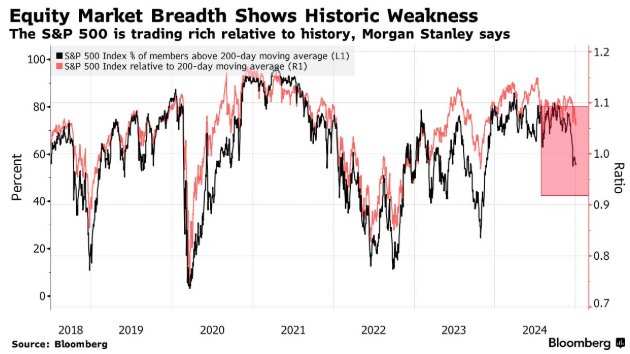Morgan Stanley said that the US stock market may face a difficult period in the next six months due to soaring US Treasury yields and inflation concerns leading to a rise in the US dollar.
The Zhitong Finance App notes that Morgan Stanley strategist Michael Wilson said that due to soaring US Treasury yields and concerns about inflation, the US stock market may face a difficult period in the next six months.
Wilson warned in a report that as 10-year US Treasury yields climbed above 4.5%, the correlation between the S&P 500 index and bond yields was “clearly negative.” The 30-year Treasury yield hit its highest level since the end of 2023 on Monday.
 Wilson said that the current level of the US dollar may put pressure on companies with a large amount of international business, and since the market breadth is already very poor, this may cause more extensive damage to the stock market in the first half of this year.
Wilson said that the current level of the US dollar may put pressure on companies with a large amount of international business, and since the market breadth is already very poor, this may cause more extensive damage to the stock market in the first half of this year.
“We think 2025 could be split into two and a half years,” the strategist wrote, and market-friendly policies such as potential tax cuts could support the stock market later this year.
The team announced a 12-month price target for the S&P 500 in November, or 6,500 points, which means the index will rise about 9% from Friday's closing price.

US stock market gains weakened in December last year due to concerns about economic growth and stronger than expected policy prospects from the Federal Reserve. Technology stocks have been the main driver of the S&P 500's gains since October 2022, yet tech stocks have been among the worst performing stocks recently.
Wilson was one of Wall Street's biggest bearers until mid-2024, when his views on the stock market became more optimistic. While he expects the S&P 500 to rise this year, he warned that the current increase is not big enough.
Wilson said that the gap between the benchmark index as a whole and its constituent stocks, as measured by the 200-day moving average, has historically been huge.
“This difference could narrow in two ways — either improving in breadth or getting closer to the S&P 500's own 200-day moving average,” the strategist wrote. “The first scenario may depend on lower interest rates, a weaker dollar, clarity in tariff policy/cabinet confirmation, and stronger earnings revisions.”

 威尔逊表示,美元目前所处的水平可能会给那些有大量国际业务的公司带来压力,而且由于市场广度已经很差,这可能会在今年上半年对股市造成更广泛的损害。
威尔逊表示,美元目前所处的水平可能会给那些有大量国际业务的公司带来压力,而且由于市场广度已经很差,这可能会在今年上半年对股市造成更广泛的损害。